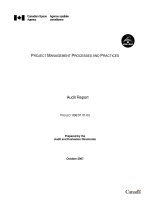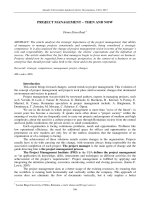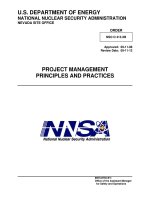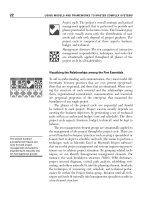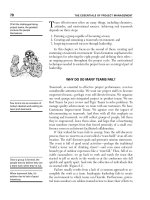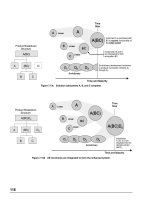PROJECT MANAGEMENT PRINCIPLES AND PRACTICES: NSO O 413.XB docx
Bạn đang xem bản rút gọn của tài liệu. Xem và tải ngay bản đầy đủ của tài liệu tại đây (308.67 KB, 69 trang )
INITIATED BY:
Office of the Assistant Manager
for Safety and Operations
U.S. DEPARTMENT OF ENERGY
NATIONAL NUCLEAR SECURITY ADMINISTRATION
NEVADA SITE OFFICE
ORDER
NSO O 413.XB
Approved: 09-11-08
Review Date: 09-11-12
PROJECT MANAGEMENT
PRINCIPLES AND PRACTICES
PROJECT MANAGEMENT PRINCIPLES AND PRACTICES
NSO O 413.XB
9-11-08 1
1. OBJECTIVE. To establish the requirements for management of the National
Nuclear Security Administration Nevada Site Office (NNSA/NSO) DOE O 413.3A
projects for acquisition of capital assets and designated activities.
2. CANCELLATION. NSO O 413.XA, PROJECT MANAGEMENT PRINCIPLES AND
PRACTICES, dated 6-16-04, and Changes thereto.
3. APPLICABILITY.
a. The provisions of this Order apply to all NNSA/NSO organizational elements.
b. Contractor requirements are contained in the Contractor Requirements
Document (CRD), Attachment 1. Compliance with the CRD is required to the
extent set forth in an NNSA/NSO contract.
4. REQUIREMENTS. For a summary of requirements, reference Attachment 2,
“Requirements Applicability Matrix.”
a. DOE O 413.3A Projects. NNSA/NSO activities, including Reimbursable Capital
Construction, which meet the requirements established in DOE O 413.3A for a
Capital Asset Project will be managed in accordance with the principles and
practices contained within the Order. Specific NNSA/NSO implementation
requirements are as follows:
(1) Designation of Federal Project Directors (FPD). The Assistant Manager
(AM) responsible for each DOE O 413.3A project will formally recommend
an FPD to the NNSA/NSO Manager for consent, and request approval as
required in DOE O413.3A, or by the Manager in the case of designated
activities.
(2) Qualification Requirements for FPDs. FPDs will be qualified under the
Department of Energy (DOE) Project Management Career Development
Program described in DOE O 361.1A, ACQUISITION CAREER
DEVELOPMENT PROGRAM.
(3) Performance Requirements.
(a) DOE O 413.3A establishes Total Project Cost (TPC) thresholds for
DOE O 413.3A projects. Formal Energy Systems Acquisition
Advisory Board (ESAAB) reviews will be conducted for
PROJECT MANAGEMENT PRINCIPLES AND PRACTICES
2
NSO O 413.XB
9-11-08
DOE O 413.3A projects, which fall under the purview of DOE and/or
NNSA in accordance with requirements contained within the Order
and Program Office requirements. For DOE O 413.3A projects
where the Manager has been designated as the Acquisition
Executive (AE), the ESAAB-equivalent process defined in
Attachment 3 will be used to review and approve Critical Decision
(CD) and Baseline Change Control (BCC) requests.
(b) When delegated by the Manager, the FPD will be the Approval
Authority for all Level 2 baseline changes within thresholds defined in
the approved Project Execution Plan (PEP). A Level 2 BCC board
will be established to advise the FPD according to the guidelines
contained in Attachment 4.
(c) The Integrated Safety and Security Management System will be
incorporated into every project.
(d) Safety requirements in the Safety Basis Review Team (SBRT)
Review Team Plan will be incorporated into all nuclear projects.
b. Designated Activities. Designated activities are activities, including non-DOE or
non-NNSA funded projects and DOE funded projects with a TPC between
$5 million and $20 million, which can be managed using tailored principles and
practices from DOE O 413.3A, and have a responsible federal individual that
controls at least two out of the three facets of project management (cost, scope,
and schedule). Construction activities supporting experiments, tests, and other
basic research projects whose end objectives are not new capital assets are
generally not considered as candidates for designated activities since the
federal project manager seldom has control over at least two out of the
three facets of project management. Designated activities will be managed in
accordance with the principles and practices as follows:
(1) Designation of Activities
. Activities will be formally designated by the
applicable AM as a designated activity, to be managed using
DOE O 413.3A project requirements as tailored, and communicated to the
Manager.
(2) Designation of Program, Project, and Functional Managers (PM/FM). The
AM responsible for each designated activity will formally recommend a PM
or FM to the Manager for approval.
PROJECT MANAGEMENT PRINCIPLES AND PRACTICES
NSO O 413.XB
9-11-08 3
(3) Qualification Requirements for PMs/FMs. PMs/FMs will be qualified in
accordance with the Technical Qualification Program (TQP) for “Technical
Program Manager” and the TQP for the applicable Functional Area if
required. Incumbents will have 18 months in which to become qualified.
(4) Performance Requirements.
(a) Designated activities will have formal integrated baselines defining
scope, cost, and schedule.
(b) Baselines for designated activities will be under formal configuration
management practices with all changes to the baseline subject to
formal BCC.
(c) PEPs or equivalents for designated activities will be developed. The
PEP or equivalent will document and provide a common
understanding of the tailored approach taken to address project
management requirements.
(d) Designated activities will have formal task plans, work authorizations,
and corresponding funding authorization documents.
(e) Risk management will be performed on all designated activities
throughout their life cycle. The plan for managing and mitigating risks
must be addressed in the PEP or equivalent document.
(f) Designated activities will utilize an Integrated Project Team (IPT)
comprised of the FPD or PM; the Contract Project Manager (CPM);
the Facility Representative (if applicable); procurement, safety, and
legal personnel; and applicable technical Subject Matter Experts
(SME), as well as other contractor personnel who have the
appropriate background and experience in project management,
contracting, fiscal, legal, security, Environmental, Safety, and Health,
Quality A, and other technical areas.
(g) Formal monthly progress reporting by either the FPD or FM will be
performed in accordance with the requirements of the applicable AM.
PROJECT MANAGEMENT PRINCIPLES AND PRACTICES
4
NSO O 413.XB
9-11-08
(h) Formal quarterly project reviews on designated activities will be
conducted by the applicable AM.
(i) Independent Project Reviews will be conducted on designated
activities when required by the applicable AM.
(j) Independent Cost Reviews will be conducted on designated activities
when required by the applicable AM.
(k) Management reviews will be conducted on designated activities as
needed to identify issues and concerns, remove barriers, and to
ensure safety and the success of the activity.
(l) Value engineering studies tailored to the risk of the designated
activity will be conducted to ensure alternative approaches are
properly considered when required by the applicable AM.
(m) Safety issues will be identified and resolved as early in the design
process as is practicable.
5. RESPONSIBILITIES.
a. DOE and NNSA Program Offices. Provide guidance and establish
requirements for conduct of projects, programs, and functions as applicable to
their area of responsibility.
b. Manager.
(1) Serves as the delegated AE for DOE and NNSA Program Offices’
activities as designated, approves FPDs for delegated DOE O 413.3A
projects, and PMs/FMs for designated activities. In this capacity,
exercises decision-making authority for CDs and BCCs for DOE O 413.3A
projects following CD-0 (which may not be delegated below the Program
Secretarial Officer or NNSA Deputy Administrator). Establishes and
chairs the NNSA/NSO ESAAB-equivalent board.
(2) Concurs in proposed FPD and forwards recommendation for approval to
the NNSA AE.
PROJECT MANAGEMENT PRINCIPLES AND PRACTICES
NSO O 413.XB
9-11-08 5
(3) Ensures the establishment of a formal IPT no later than CD-0 for all
DOE O 413.3A projects.
c. Executive Council. Serves as the NNSA/NSO ESAAB-equivalent board for
delegated DOE O 413.3A projects.
d. Assistant Manager for Safety and Operations (AMSO). Provides the
Secretariat for the NNSA/NSO ESAAB-equivalent board.
e. Assistant Managers. Establish policies and procedures for the management of
designated activities under their purview. Categorize activities as
DOE O 413.3A projects and designated activities. As delegated by the
Manager, approve Level 2 project baseline changes and allocation of NNSA
contingency funds.
f. Federal Project Directors. In addition to the duties delineated in
DOE O 413.3A, the FPD will:
(1) Ensure the appropriate engineering work products are implemented in
construction, fabrication, and modification associated with designated
projects in accordance with best industry practices, design criteria, and
DOE, NNSA, and NNSA/NSO policies and requirements.
(2) Serve as the single point of contact between federal and contractor staff
for all matters relating to the project and its performance.
(3) Serve as the Contracting Officer Representative, if appointed.
g. SBRT Leader
. Participates on the IPT and coordinates the integration of the
SBRT Review Plan into the project for nuclear projects.
6. REFERENCES.
a. DOE O 361.1B, ACQUISITION CAREER DEVELOPMENT PROGRAM, dated
01-24-08; Chapter IV, “Project Management Career Development Program
Module.”
b. DOE O 413.3A, PROGRAM AND PROJECT MANAGEMENT FOR THE
ACQUISITION OF CAPITAL ASSETS, dated 07-28-06.
PROJECT MANAGEMENT PRINCIPLES AND PRACTICES
6
NSO O 413.XB
9-11-08
c. DOE M 413.3-1, PROJECT MANAGEMENT FOR THE ACQUISITION OF
CAPITAL ASSETS, dated 03-28-03, Chapters 4 through 16 and Appendices.
d. DOE O 420.1B, FACILITY SAFETY, dated 12-22-05.
e. DOE O 425.1C, STARTUP AND RESTART OF NUCLEAR FACILITIES,
dated 03-13-03.
f. DOE P 450.4, SAFETY MANAGEMENT SYSTEM POLICY, dated 10-15-96.
g. DOE M 450.4-1, INTEGRATED SAFETY MANAGEMENT SYSTEM MANUAL,
dated 11-01-06.
h. DOE G 450.4-1B, INTEGRATED SAFETY MANAGEMENT SYSTEM GUIDE,
dated 03-01-01.
i. DOE G 413.3-2, QUALITY ASSURANCE GUIDE FOR PROJECT
MANAGEMENT, dated 06-27-08.
j. DOE G 413.3-3, SAFEGUARDS AND SECURITY FOR PROGRAM AND
PROJECT MANAGEMENT, dated 11-15-07.
k. DOE G 413.3-6, HIGH SUSTAINABLE BUILDING, dated 05-06-08.
l. DOE G 413.3-10, EARNED VALUE MANAGEMENT SYSTEM (EVMS), dated
05-06-08.
m. DOE G 413.3-13, U. S. DEPARTMENT OF ENERGY ACQUISITION
STRATEGY GUIDE FOR CAPITAL ASSETS PROJECTS, dated 07-22-08.
n. DOE G 413.3-17, MISSION NEED STATEMENT GUIDE, dated 06-20-08.
o. DOE G 413.3-11, PROJECT MANAGEMENT LESSONS LEARNED,
dated 08-05-08.
PROJECT MANAGEMENT PRINCIPLES AND PRACTICES
NSO O 413.XB
9-11-08 7
7. DEFINITIONS.
a. Baseline. A formal description of the planned technical scope, schedule, and
cost of a project against which project performance is measured. The technical
baseline is the reference set of high-level technical documents that contain the
technical requirements necessary to satisfy mission need. The schedule
baseline is the set of sequenced activities, critical path, and approved
milestones for performance of the project. The cost baseline allocates
resources and estimated costs against the scheduled activities for the total
scope of work.
b. Baseline Change Control. The process by which requests for changes to an
approved baseline are evaluated, justified, and approved.
c. BCC Board. A group qualified in technical matters involving quality, reliability,
financial, schedule, safety, health, environmental, legal, and contractual issues
including SMEs for the technology employed in a project with responsibility to
advise the chairperson who holds change control authority.
d. Contractor Project Manager. The contractor official responsible and
accountable for successful execution of contractor’s project scope of work. The
CPM is responsible for the day-to-day management of the project and delivering
the means, methods, and resources to meet the project end-point requirements
and the intermediate requirements that the FPD determines are value-added
and necessary to achieve project success.
e. Designated Activities. Designated activities are activities, including Work for
Others projects, which can be managed using tailored principles and practices
from DOE O 413.3A, and have a responsible federal individual that controls at
least two out of the three facets of project management (cost, scope, and
schedule).
f. DOE and NNSA Program Managers
. Individuals in an organization or activity
who are responsible for the management of a specific function or functions,
budget formulation, and the execution of the approved budget. The DOE and
NNSA Program Managers receive approved funding from the Office of the
Controller identifying program dollars available to accomplish the assigned
functions.
g. DOE and NNSA Program Offices. The DOE and NNSA organizational elements
responsible for managing a program and overseeing activities conducted by an
operations or field office.
NSO O 413.XB
9-11-08
Attachment 1
Page 1
CONTRACTOR REQUIREMENTS DOCUMENT (CRD)
The National Nuclear Security Administration Nevada Site Office (NNSA/NSO)
Performance-Based Management, Environmental Management Support, and Security
Contractors must have project management systems that satisfy the following
requirements:
NOTE: These requirements were taken from DOE O 413.3A. Based on the tailoring
found in the NNSA/Defense Program Requirements Manual for Project Management,
this CRD expands the applicability of the DOE O 413.3A CRD, for DOE O 413.3A
Projects with a Total Project Cost greater than the congressionally-mandated upper limit
for a DOE General Plant Project (GPP), CRD requirements (1-5) below, will be utilized
as stated. For GPPs and Designated Activities, refer to Attachment 2, Requirements
Applicability Matrix, for tailoring of these requirements.
1. The industry standard for project control systems described in American National
Standards Institute/Electronic Industries Alliance-748, Earned Value Management
Systems, must be implemented on all projects for control of project performance
during the project execution phase.
2. Cost and schedule performance, milestone status, and financial status must be
reported to NNSA/NSO on a monthly basis using NNSA/NSO-approved Work
Breakdown Structure elements and data elements for all projects, except for time-
and-materials contracts, firm-fixed-priced contracts, or level-of-effort support
contracts, for control of project performance during the project execution phase.
The report must also include variance analyses and Corrective Action Plans (CAP)
that integrate cost, schedule, and scope if variances exceed NNSA/NSO-
established reporting thresholds. Also reported will be analyses of cost and
schedule trends, financial status, and BCC activity including the allocation of
management reserve, potential problems, and critical issues.
3. For project subcontracts that must be accomplished by the Performance-Based
Management Contractor (PBMC), the contractor must have a written Acquisition
Plan, which is appropriate for the requirement and dollar value of each subcontract
and consistent with the intent of the Federal Acquisition Regulation. The
Acquisition Plan for a project subcontract to be awarded by the PBMC is developed
by a team of contractor employees including, as a minimum, the prospective PBMC
PROJECT MANAGEMENT PRINCIPLES AND PRACTICES
Attachment 1
Page 2
NSO O 413.XB
9-11-08
Project Manager and Contract Negotiator. The Acquisition Plan will also be
concurred on by the NNSA/NSO Contracting Officer and Federal Project Director/
Program Manager-Project Manager/Functional Manager.
4. Technical performance analyses and CAPs must be reported to NNSA/NSO for
variances to the project baseline objectives resulting from design reviews,
components, system tests, and simulations.
5. An integrated contractor technical, cost, and schedule baseline must be developed
and maintained using documented contractor change control. Technical, cost, and
schedule data must also be provided, as requested, by NNSA/NSO programs, for
development and change control associated with federal baselines.
PROJECT MANAGEMENT PRINCIPLES AND PRACTICES
NSO O 413.XB
9-11-08
Attachment 2
Page 1
* No Critical Decisions (CD) are involved, and Baseline Change Control is at AM level already.
** Funded by non-DOE or non-NNSA entities.
*** GPP quarterly reviews will be conducted as an NNSA/NSO management review.
NATIONAL NUCLEAR SECURITY ADMINISTRATION
NEVADA SITE OFFICE (NNSA/NSO)
REQUIREMENTS APPLICABILITY MATRIX
DOE O 413.3A Projects Designated Activities
NNSA/NSO Category
“Major Systems” Reimbursable Capital
Construction**
“Other” General Plant Project
(GPP)
Applicable Range in Total
Project Cost (TPC) or
Annual Cost (AC)
TPC ≥ $750M
Congressionally
Mandated Upper Limit for
a Department of Energy
(DOE) GPP< TPC <
$750M
Congressionally
Mandated Upper Limit for
a DOE GPP< TPC <
$750M
TPC ≤ Congressionally
Mandated Upper Limit for
a DOE GPP
AC ≥ $20M
AC < $20M
Responsible Individual(s)
for Planning and Execution
Federal Project
Director
Federal Project Director Federal Project Director Federal Project Director Project, Program, or
Functional Manager
Project, Program, or
Functional Manager
Formal Designation of
Responsible Individual(s)
By DOE and NNSA
Acquisition Executives
(AE)
By NNSA/NSO Manager By DOE and NNSA AEs;
May Be Delegated to the
NNSA/NSO Manager for
Projects With
TPC<$100M; May Be
Delegated to the
Assistant Manager (AM)
for TPC <$20M
By NNSA/NSO Manager By NNSA/NSO
Manager
By NNSA/NSO AM
With Concurrence
by NNSA/NSO
Manager
Formal Qualification of
Responsible Individual(s)
DOE Project
Management Career
Development
Program,
DOE O 361.1B,
Chapter IV
DOE Project
Management Career
Development Program,
DOE O 361.1B,
Chapter IV
DOE Project
Management Career
Development Program,
DOE O 361.1B,
Chapter IV
DOE Project Management
Career Development
Program, DOE O 361.1B,
Chapter IV
Technical
Qualifications
Program (TQP) for
“Technical Program
Manager” and TQP
for the Applicable
Functional Area if
Required
TQP for “Technical
Program Manager,”
and TQP for the
Applicable
Functional Area if
Required
Energy Systems
Acquisition Advisory
Board (ESAAB) CDs Apply
Yes Yes CDs Applied by
NNSA/NSO ESAAB
Equivalent
Yes No* No No
Management Advisory
Board
DOE and NNSA
ESAABs
NNSA/NSO ESAAB-
Equivalent
Program Office ESAAB-
Equivalent or NNSA/NSO
ESAAB-Equivalent
As Defined by Decision
Authority
Not Applicable* Not Applicable*
PROJECT MANAGEMENT PRINCIPLES AND PRACTICES
Attachment 2
Page 2
NSO O 413.XB
9-11-08
* No Critical Decisions (CD) are involved, and Baseline Change Control is at AM level already.
** Funded by non-DOE or non-NNSA entities.
*** GPP quarterly reviews will be conducted as an NNSA/NSO management review.
DOE O 413.3A Projects Designated Activities
NNSA/NSO Category
“Major Systems” Reimbursable Capital
Construction**
“Other” General Plant Project
(GPP)
Decision Authority for CDs DOE and NNSA AEs NNSA/NSO Manager as
AE
DOE and NNSA AEs or
NNSA/NSO Manager as
AE
Federal Project Director Applicable
NNSA/NSO AM
Applicable
NNSA/NSO AM
Establish Formal
Performance Baselines
Yes Yes Yes Yes Yes Yes
Formal Configuration
Management Applies
Yes Yes Yes Yes Yes Yes
Applicable Execution
Document(s)
Acquisition Strategy
Project Execution Plan
(PEP)
Acquisition Strategy PEP Acquisition Strategy PEP PEP (Contractor’s Plan) Execution Plan
(Contractor’s Plan as
Applicable)
Execution Plan
(Contractor’s Plan
as Applicable)
Authorizations Work Authorization
and Corresponding
Funding Authorization
From NNSA/NSO AM
Work Authorization and
Corresponding Funding
Authorization From
NNSA/NSO AM
Work Authorization and
Corresponding Funding
Authorization From
NNSA/NSO AM
Project Authorization and
Corresponding Funding
Authorization From
NNSA/NSO AM
Approved Task Plans Approved Task
Plans
Utilize an Integrated
Project Team
Yes Yes Yes When Required by
Decision Authority
When Required by
Decision Authority
When Required by
Decision Authority
Formal Monthly Reporting
of Progress and
Performance
Yes Yes to Customer and
NNSA/NSO
Yes Yes Yes Yes
Conduct Quarterly
Performance Review(s)
Yes Yes Yes No*** Yes Yes
Conduct External
Independent Review(s)
(EIR) and/or Independent
Project Review(s) (IPR)
EIR for CD-2 and
CD-3; IPRs as
Requested by AE
IPR for CD-3 and IPRs
as Requested by AE
EIR for CD-2; IPR for
CD-3 and IPRs as
Requested by AE
When Required by
Decision Authority
When Required by
Decision Authority
When Required by
Decision Authority
Conduct Independent Cost
Estimates and/or
Independent Cost
Review(s)
Yes Yes Yes When Required by
Decision Authority
When Required by
Decision Authority
When Required by
Decision Authority
Conduct NNSA/NSO
Management Review(s)
As Needed As Needed As Needed As Needed As Needed As Needed
Conduct Value Engineering
Studies Tailored to the
Risk of the Project
Yes Yes Yes When Required by
Decision Authority
When Required by
Decision Authority
When Required by
Decision Authority
PROJECT MANAGEMENT PRINCIPLES AND PRACTICES
NSO O 413.XB
9-11-08
Attachment 3
Page 1
NATIONAL NUCLEAR SECURITY ADMINISTRATION
NEVADA SITE OFFICE (NNSA/NSO)
ENERGY SYSTEMS ACQUISITION ADVISORY BOARD (ESAAB)-EQUIVALENT
REQUIREMENTS, UNDERSTANDINGS, AND EXPECTATIONS
FOREWORD
This document reflects the current requirements, understandings, and expectations
related to the NNSA/NSO ESAAB-equivalent process.
PROJECT MANAGEMENT PRINCIPLES AND PRACTICES
Attachment 3
Page 2
NSO O 413.XB
9-11-08
TABLE OF CONTENTS
Page
FOREWORD 1
DEFINITIONS 4
1. ENERGY SYSTEMS ACQUISITION ADVISORY BOARD 4
2. NNSA/NSO ESAAB-EQUIVALENT 4
3. CRITICAL DECISION 4
4. BASELINE CHANGE PROPOSAL 5
5. NNSA/NSO AE 5
6. FEDERAL PROJECT DIRECTOR 5
7. CONTRACTOR PROJECT MANAGER 5
8. PROGRAM OFFICE 5
9. DESIGNATED ACTIVITIES 5
10. DOE O 413.3A PROJECTS 5
NNSA/NSO ESAAB-EQUIVALENT PROCESS 6
1. BACKGROUND 6
2. PURPOSE 6
3. APPLICABILITY 6
4. GOALS AND OBJECTIVES 7
5. ROLES AND RESPONSIBILITIES 8
a. Acquisition Executive 8
b. Board Members 9
c. Program Office 9
d. Federal Project Director 10
e. ESAAB-Equivalent Secretariat 10
6. BOARD MEMBERS 11
7. ESAAB-EQUIVALENT PROCESS 12
a. Scheduling 12
b. Review and Comment Resolution 13
c. Prebriefings 14
d. ESAAB-Equivalent Board Meetings 14
PROJECT MANAGEMENT PRINCIPLES AND PRACTICES
NSO O 413.XB
9-11-08
Attachment 3
Page 3
TABLE OF CONTENTS
(Continued)
Page
APPENDIX A—NNSA/NSO ESAAB-EQUIVALENT PROCESS FLOWCHART
FOR CD AND BCP ACTIONS 16
APPENDIX B—ESAAB-EQUIVALENT PROCESS TIMELINE 17
APPENDIX C—CD INFORMATION OUTLINES 18
APPENDIX D—DECISION MEMORANDUM OUTLINE 46
APPENDIX E—NNSA/NSO ESAAB-EQUIVALENT PRESENTATION OUTLINE 47
PROJECT MANAGEMENT PRINCIPLES AND PRACTICES
Attachment 3
Page 4
NSO O 413.XB
9-11-08
DEFINITIONS
1. ENERGY SYSTEMS ACQUISITION ADVISORY BOARD EQUIVALENT. A
multifunctional body of representatives designated by the NNSA/NSO Acquisition
Executive (AE) to provide technical and managerial advice and assistance for Critical
Decision (CD) points and Baseline Change Proposals (BCP).
2. NNSA/NSO ESAAB-EQUIVALENT. The process by which the NNSA/NSO AE
reviews and decides on CDs and BCPs for those projects delegated to NNSA/NSO
by the Department of Energy (DOE) and NNSA. This is accomplished by using
NNSA/NSO elements (board) to review the project and provide advice to the AE.
3. CRITICAL DECISION. The CD is an approval given at specific points in a project’s
life cycle when transitioning from one project phase to another phase (e.g., from
conceptual design to preliminary design). The CDs are used as review points to
ensure the AE that the project is ready to proceed into the next phase and remains a
mission need.
4. BASELINE CHANGE PROPOSAL. A BCP is a request made to make a change to
the scope, cost, and/or schedule baselines of a project. The BCP is reviewed at the
appropriate Change Control Board level and approved/disapproved by the
appropriate Change Control Manager.
5. NNSA/NSO AE. The Site Office Manager who acts as the AE for the NNSA/NSO
ESAAB-equivalent board process.
6. FEDERAL PROJECT DIRECTOR (FPD)
. The FPD is the NNSA/NSO employee
assigned oversight of the project and the single NNSA/NSO interface with the
Contractor Project Manager (CPM). The FPD will be responsible and accountable
for the Project Management activities of one or more discrete projects under his/her
cognizance and is usually the single point of contact between the government staff
and the contractor staff for all matters relating to the project and its execution.
7. CONTRACTOR PROJECT MANAGER. The CPM is, generally, from the
Performance-Based Management Contractor organization, the Architect-Engineer
firm, Construction Management firm, or is a non-DOE or non-NNSA federal
employee assigned to direct the project. The CPM is responsible and accountable
for the day-to-day execution of assigned projects within approved cost, schedule,
and scope baselines, as defined in the Project Execution Plan.
PROJECT MANAGEMENT PRINCIPLES AND PRACTICES
NSO O 413.XB
9-11-08
Attachment 3
Page 5
8. PROGRAM OFFICE. The advocate promoting the project could be DOE, NNSA, or
NNSA/NSO. This is the organization responsible for planning and oversight of the
execution of the specific activities and missions that comprise the program.
9. DESIGNATED ACTIVITIES. Designated activities are activities, including non-DOE
or non-NNSA funded projects and DOE-funded projects with a Total Project Cost
between $5 million and $20 million, which are designated to be managed using
tailored principles and practices from DOE O 413.3A, and have a responsible
federal individual that controls at least two out of the three facets of project
management (cost, scope, and schedule).
10. DOE O 413.3A PROJECTS. Projects governed by DOE Order 413.3A and
associated directives and guides.
PROJECT MANAGEMENT PRINCIPLES AND PRACTICES
Attachment 3
Page 6
NSO O 413.XB
9-11-08
NNSA/NSO ESAAB-EQUIVALENT PROCESS
1. BACKGROUND. DOE O 413.3A, PROGRAM AND PROJECT MANAGEMENT
FOR THE ACQUISITION OF CAPITAL ASSETS, sets the requirements for
management of DOE O 413.3A projects and designated activities.
2. PURPOSE. This document specifies the ESAAB-equivalent procedures that will be
followed by NNSA/NSO for projects and authority delegated by the Program
Secretarial Officer (PSO) or NNSA Deputy Administrator to NNSA/NSO and for
designated activities
3. APPLICABILITY.
a. The NNSA/NSO ESAAB-equivalent is responsible for advising the NNSA/NSO
AE on CDs for all delegated projects and associated BCPs. Projects exempted
from the NNSA/NSO ESAAB-equivalent process are General Plant Projects
(GPP); accelerator improvement projects; and capital equipment, facilities, and
infrastructure projects less than the congressionally mandated upper limit for a
DOE GPP. The AE for the NNSA/NSO ESAAB-equivalent will make the final
decision on the action presented before the board based upon the input from
the board members. The board members will act as Subject Matter Expert
(SME) in the evaluation of the project proposal, providing to the AE expert
analysis, advice, and recommendations with respect to the implications of the
CD or BCP being discussed.
b. At the request of board members, the NNSA/NSO ESAAB-equivalent will be
supplemented with other disciplines or SMEs to meet the DOE O 413.3A
requirements. The NNSA/NSO support staff may be asked to participate in
preliminary review meetings to resolve issues at the appropriate level.
NNSA/NSO ESAAB-equivalent members will advise the AE as to the suitability
for the proposed decision or baseline change.
4. GOALS AND OBJECTIVES
.
a. The concept of using ESAABs at CD points in federal projects was developed
from the Office of Management and Budget (OMB) Circular A-109, Major
Systems Acquisitions. The goals and objectives of this procedure accordingly
reflect those of OMB Circular A-109.
PROJECT MANAGEMENT PRINCIPLES AND PRACTICES
NSO O 413.XB
9-11-08
Attachment 3
Page 7
(1) To ensure the NNSA/NSO acquisition process reflects an integrated
approach to matching program requirements with the project development
and execution process.
(a) Each acquisition fulfills a mission need and can achieve adequate
levels of performance and reliability in its intended operating
environment.
(b) Planning is built upon this mission need.
(c) Competitive design concepts are evaluated, whenever economically
beneficial.
(d) Appropriate tradeoffs are made between investment costs, ownership
costs, schedule, and performance.
(e) A project-specific acquisition strategy is developed for each
acquisition as soon as it is decided to solicit alternative design
concepts.
(f) Adequate system tests and evaluations are conducted.
(g) Performance is assessed against project baselines and these
assessments are provided to the AE at CD points.
(h) Ensure safety requirements are adequately addressed at every
phase of the project.
(2) To provide appropriate AE oversight to the acquisition process for projects
greater than the congressionally mandated upper limit for a DOE GPP
(3) To ensure line management involvement and accountability for project
performance.
(4) To demonstrate commitment to improving the acquisition process to
departmental and congressional elements.
b. The NNSA/NSO ESAAB-equivalent process also provides a vehicle by which
NNSA/NSO management can reinforce departmental policy, make necessary
course corrections, and verify all organizational elements are working towards
the same goal.
PROJECT MANAGEMENT PRINCIPLES AND PRACTICES
Attachment 3
Page 8
NSO O 413.XB
9-11-08
5. ROLES AND RESPONSIBILITIES. The following are NNSA/NSO ESAAB-
equivalent participants’ functions:
a. Acquisition Executive.
(1) Appoints board members and/or SMEs to address key issues that need to
be addressed in CDs including, but not limited to: Program Requirements,
Legal, Budget, Environmental, Safeguards and Security, Safety and
Health, Procurement, Project Management and Control, and Quality
Assurance (QA).
(2) Requests participation of a representative board member from Office of
Engineering and Construction Management (OECM) for projects with a
TPC greater than $20 million.
(3) Presides over NNSA/NSO ESAAB-equivalent meetings.
(4) Makes decisions on disposition of all requested CDs and BCPs, based
upon input from board members.
(5) Assigns action items that may result from meeting discussions.
(6) Ensures board members fulfill their responsibility.
(7) Reviews Corrective Action Plan (CAP) reports on assigned project action
items and independent reviews.
b. Board Members
.
(1) Provide timely review of project materials.
(2) Fully evaluate project in their own area of expertise associated with the
CD request.
(3) Prepare the directed questions/comments on specific project items that
need resolution and submit them, through the ESAAB-equivalent
Secretariat to the FPD.
(4) Work to resolve issues with project team.
PROJECT MANAGEMENT PRINCIPLES AND PRACTICES
NSO O 413.XB
9-11-08
Attachment 3
Page 9
(5) Attend all NNSA/NSO ESAAB-equivalent meetings or provide an
alternate.
(6) Provide recommendation of disposition of CDs to the AE.
(7) NNSA/NSO ESAAB-equivalent board members will act as SMEs in the
evaluation of the proposed CD or BCP to:
(a) Ensure Defense Programs (DP) and Environmental Management
(EM) requirements are met and common construction/business
practices are followed.
(b) Provide effective recommendations and advice to the AE.
c. Program Office.
(1) Works with the FPD to prepare project and materials for presentation to
board.
(2) Coordinates with the FPD and NNSA/NSO ESAAB-equivalent Secretariat
to schedule meetings.
(3) Works with the FPD to answer inquiries/resolve issues with board
members.
(4) The Program Office Representative, as part of the project team,
coordinates with the FPD and NNSA/NSO ESAAB equivalent Secretariat
to manage the project through the NNSA/NSO ESAAB-equivalent
process.
d. Federal Project Director.
(1) Establishes a schedule for required CDs within the overall project
schedule.
(2) Coordinates preparation of project documents supporting the decisions
process.
(3) Coordinates with the Program Office and NNSA/NSO ESAAB-equivalent
Secretariat to schedule ESAAB-equivalent meetings.
PROJECT MANAGEMENT PRINCIPLES AND PRACTICES
Attachment 3
Page 10
NSO O 413.XB
9-11-08
(4) Prepares and presents the CD presentation to the NNSA/NSO ESAAB-
equivalent presenting the proposed CD, identifying all issues associated
with the proposed decision.
(5) Works with the Program Office to respond to NNSA/NSO ESAAB-
equivalent questions/requests and resolves issues.
(6) Coordinates the development of a Decision Memorandum for AE
signature with the ESAAB-equivalent Secretariat to document the CD and
to capture any action items resulting from the ESAAB meeting.
5. ESAAB-Equivalent Secretariat.
(1) Coordinates NNSA/NSO ESAAB-equivalent schedules for the AE.
(2) Keeps the OECM and the DOE and NNSA ESAAB-equivalents informed
(through the DOE and NNSA Program Offices) on schedule and status.
(3) Offers improvements/suggestions on project planning and process to the
AE, Program Office, and Project Team.
(4) Works with ESAAB members to prepare Additional Information Requests
(AIR) and provides to the FPD for action and response.
(5) Advises AE on the technical and management significance of issues
identified from NNSA/NSO ESAAB-equivalent and quarterly reviews.
(6) Provides technical reviews and comments on the planning and execution
of construction projects.
(7) Develops lines of inquiry for use at the NNSA/NSO ESAAB-equivalent
meeting.
(8) Records minutes and action items resulting from ESAAB reviews and
meetings.
(9) Coordinates the decision memorandum process so:
(a) Decisions are appropriately documented in a timely fashion.
PROJECT MANAGEMENT PRINCIPLES AND PRACTICES
NSO O 413.XB
9-11-08
Attachment 3
Page 11
(b) Action items/issues are captured and included in the decision
memorandum package.
(10) Distributes meeting minutes and decisions to the FPD, CPM, Office of
Project Management and System Support (NA-54), OECM, and
Headquarters Program Offices as applicable.
(11) Maintains database/library of NNSA/NSO ESAAB-equivalent board
meetings and actions for all delegated projects.
(12) Works with the FPD, Program Office, and NNSA/NSO ESAAB-equivalent
board members to facilitate review process, arranges meetings, and
tracks issues to resolution.
(13) Works with all parties to improve the NNSA/NSO ESAAB-equivalent board
process.
6. BOARD MEMBERS. The following table shows the current membership of the
NNSA/NSO ESAAB-equivalent who will review and/or approve CDs and BCPs for
all delegated projects:
